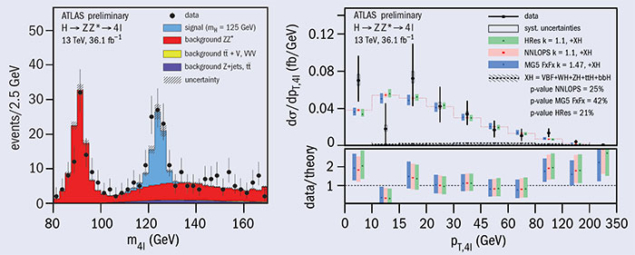
The ATLAS collaboration has released new results on measurements of the properties of the Higgs boson using the full LHC proton–proton collision data set collected at a centre-of-mass energy of 13 TeV in 2015 and 2016, corresponding to an integrated luminosity of 36.1 fb–1.
One of the most sensitive measurement channels involves Higgs boson decays via two Z bosons to four leptons (two pairs of oppositely charged electrons or muons). Although only occurring in about one in every 8000 Higgs decays, it gives the cleanest signature of all the Higgs decay modes.
Using this channel, ATLAS measured both the inclusive and differential cross-sections for Higgs boson production. Although these have been measured before at lower LHC collision energy, the increased integrated luminosity and larger cross-section compared to LHC Run 1 allows their magnitudes to be determined with increased precision. In total, around 70 Higgs boson to four-lepton events were measured with a fit to the invariant mass distribution, allowing the inclusive cross-section to be measured with an accuracy of about 16%.
Candidate Higgs boson events were corrected for detector measurement effects and classified according to their kinematic properties to measure differential production cross-sections. Among these, the measurement of the momentum of the Higgs boson transverse to the beam axis probes different Higgs boson production mechanisms. By measuring the number and properties of jets produced in these events, Higgs boson production via the fusion of two gluons was studied. The measured inclusive and differential cross-sections were found to be in agreement with the Standard Model (SM) predictions. The results were used to constrain possible anomalous Higgs boson interactions with SM particles.
Further reading
ATLAS Collaboration 2017 ATLAS-CONF-2017-032.








